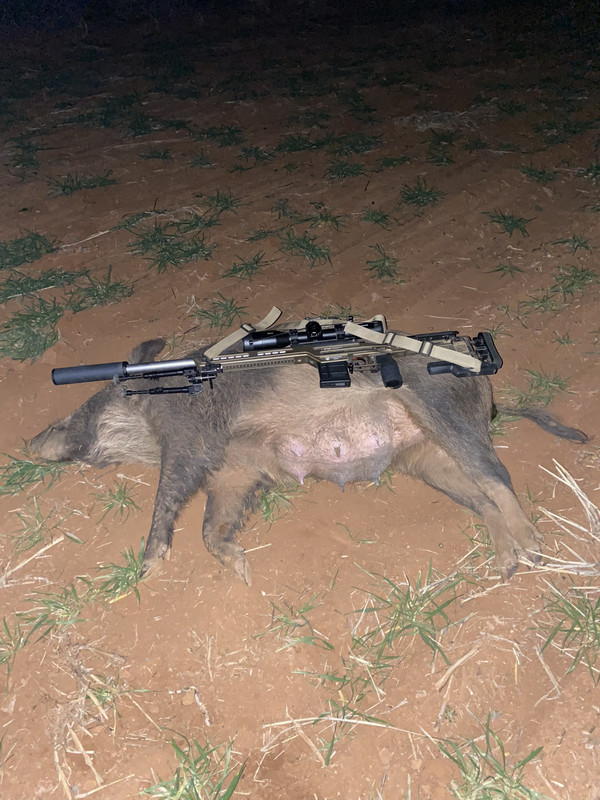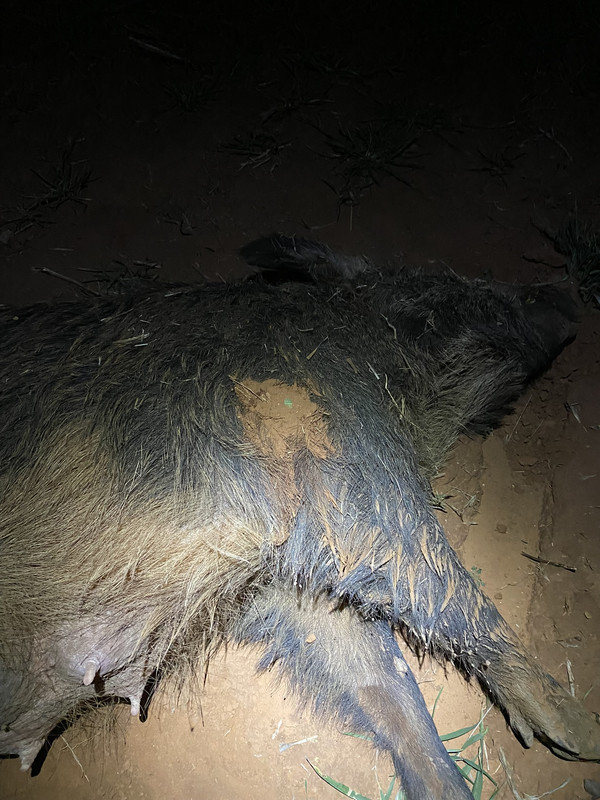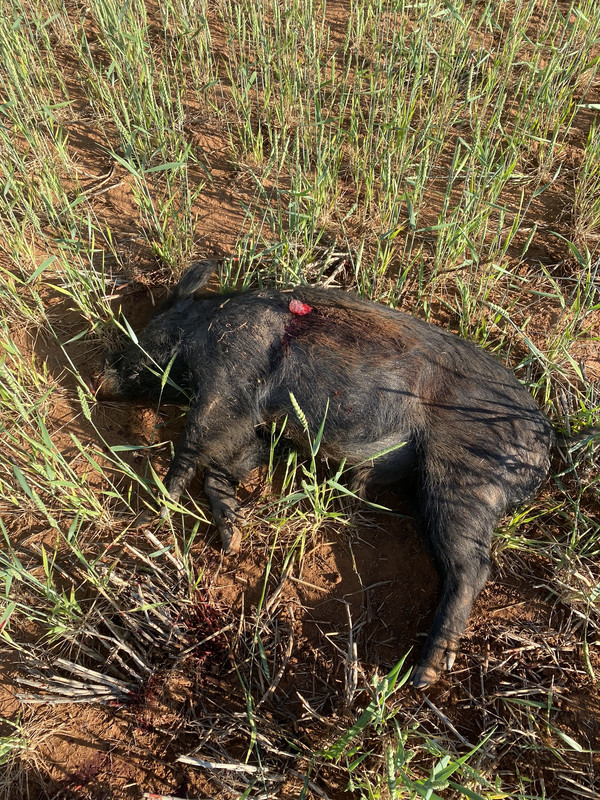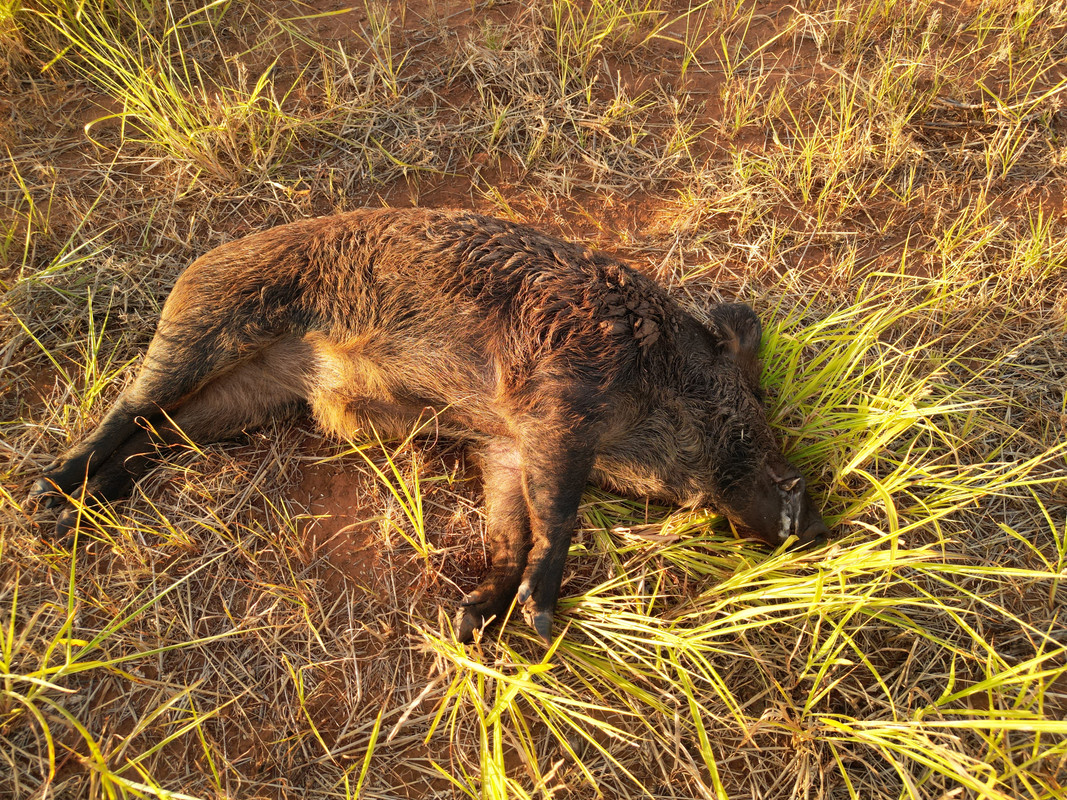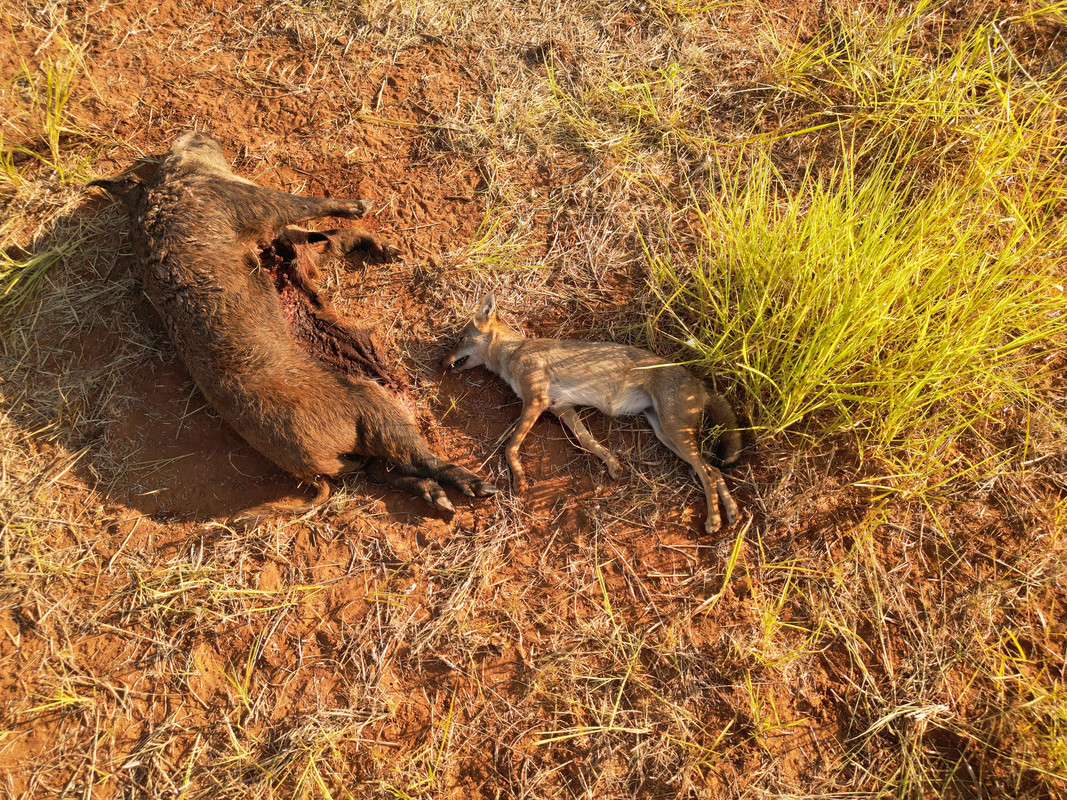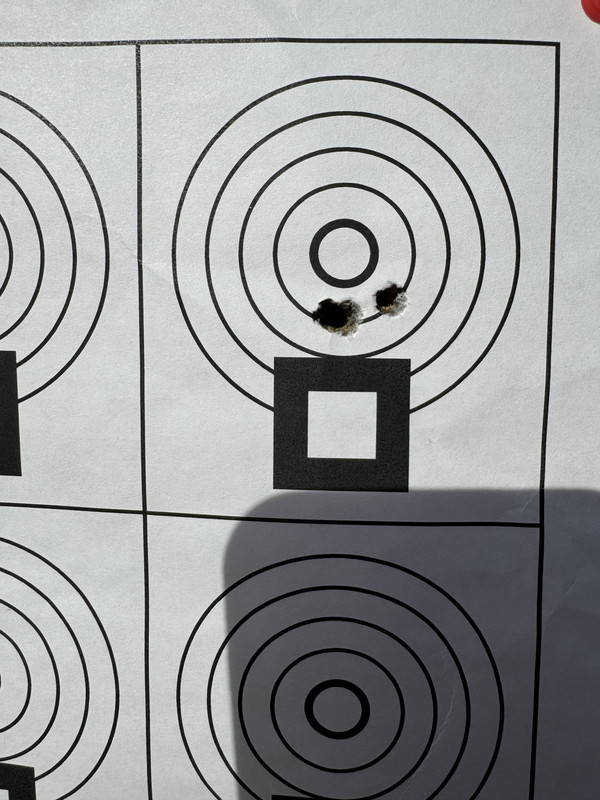Hondo64d
Lil-Rokslider
Took my heavy gun up to Jon Beanland of Beanland Custom Rifles to have an M24 contour Osprey Barrel Works barrel blank chambered and fitted in .22 GT. Jon does absolutely 1st class work and having used several ‘smiths over the years, I’m convinced there is no one that does better.
The .22 GT is simply the 6mm GT necked down to .224. It has the same case capacity as the 22-250 but in a much better designed case. The case has much less taper than the 22-250 so works much better in a DBM magazine and cases stretch much less during the firing/resizing process. COAL is short enough that reaching the lands is easy in a 2.8” or longer box.
Anyway, Jon had good things to say about the Osprey barrel. Said it was super straight, so much so that there was no need to index the curve, because there just wasn’t any. Also said the groove depth was very uniform. He thought the barrel was a bit harder than most, judging by how many plunges he made with the reemer. He cut the chamber with an Alpha Munitions reemer, and the chamber was a thing of beauty. I had him finish the barrel at 20” for suppressor use.
Loaded a few round of ammo just to try and find max. Used virgin Alpha brass, CCI 450s, H4350, and 88gr ELD-Ms. Loaded five rounds at 33.6gr to zero, and one round each of 34, 34.4, 34.8, 35.2, 35.6, and 36 to try and find max pressure. No case prep on the virgin brass, just deburring and chamfering. Used an RCBS Matchmaster 6mm GT seating die. Runout at the ogive went anywhere from .001” to .006”. I’m not satisfied with anything more than .002” runout, but with virgin brass, it’s not uncommon. I’m confident I’ll get much straighter ammo after I’ve fireformed the brass.
I’m using Magpul AICS patterned magazines and I ran five rounds through to check feeding. Feeding was flawless, which is not attainable with the 22-250 with more than five rounds, due to its case taper.
The thing that initially impressed me the most was how close the first round out of the barrel hit to the zero from the previous barrel (Bartlein 6.5 Creedmoor). Without even a boresight, the first round hit on the left edge of the bullseye, only 1/2 mil from the previous zero. I made an adjustment and shot the next four of the 33.6gr charge. They went into about .6” with 3 of the four being in the .2s. Made another adjustment and shot the last six in the pressure series. Four consecutive charges out of the remaining six went into about a .4” group. 34gr was a little out of the group, as was 36gr, but 34.4, 34.8, 35.2, and 35.6gr all went into about .4”. Based on how well 34.4 - 35.6gr grouped, I was pretty sure I could pick from 34.8 to 35.2gr and run with it. Saw no excess pressure signs from any of the charges. Bolt lift was good, no ejector marks, and primers were nice and round.
I measured some of the fired brass. When checking runout at the neck, I struggled to see any needle movement on the fired brass, indicating a very concentric chamber. Using a headspace comparator, the brass grew less than .001” on firing. I was able to slide bullets into the necks of the fired brass with my fingers but there was some resistance, indicating it’s a fairly tight necked chamber. I ran a couple of the fired brass through the Matchmaster sizing die with a .249” bushing and bumped the shoulders about .0005”. Runout at the neck on the sized cases was well under .001”.
Finally, I loaded five more rounds from 36.4 to 38gr to continue finding my max charge. The next range session I shot those, observing slight ejector marks with 37.6 and 38gr. Alpha Munitions OCD brass is seriously hard stuff and if I’m seeing ejector marks with it, I’m well past sane pressure limits, so decided to my first load development attempts in ernest would be around 36gr, hoping to find accuracy with 88gr ELD-Ms at 3000fps or more from the 20" Osprey barrel. Alas, it was not to be. This barrel decidedly did not like any charges of H4350 greater than 36gr, grouping a bit over 1" with for 10 shots. I remembered back to when I was finding max, that four consecutive charges from 34 to 35.6gr all went into the same ragged hole so decided to try 35gr. Bingo! 35gr grouped 10 shots into .443" center to center. You can see ”flyers” at 6 o’clock and 8 o’clock in the group. By the time I was six shots in, mirage off the suppressor was significant. Had it not been for that I think I could have done even better. Eight of the ten shots are probably in the high .2s. Didn't chrono it but based on come ups at 900, velocity is about 2900. I had hoped for more speed, but I don't think 100fps is going to make or break a shot. Recoil is so light that spotting your impacts is a given and it is just a super fun rifle to shoot. Overall, very pleased so far.
John
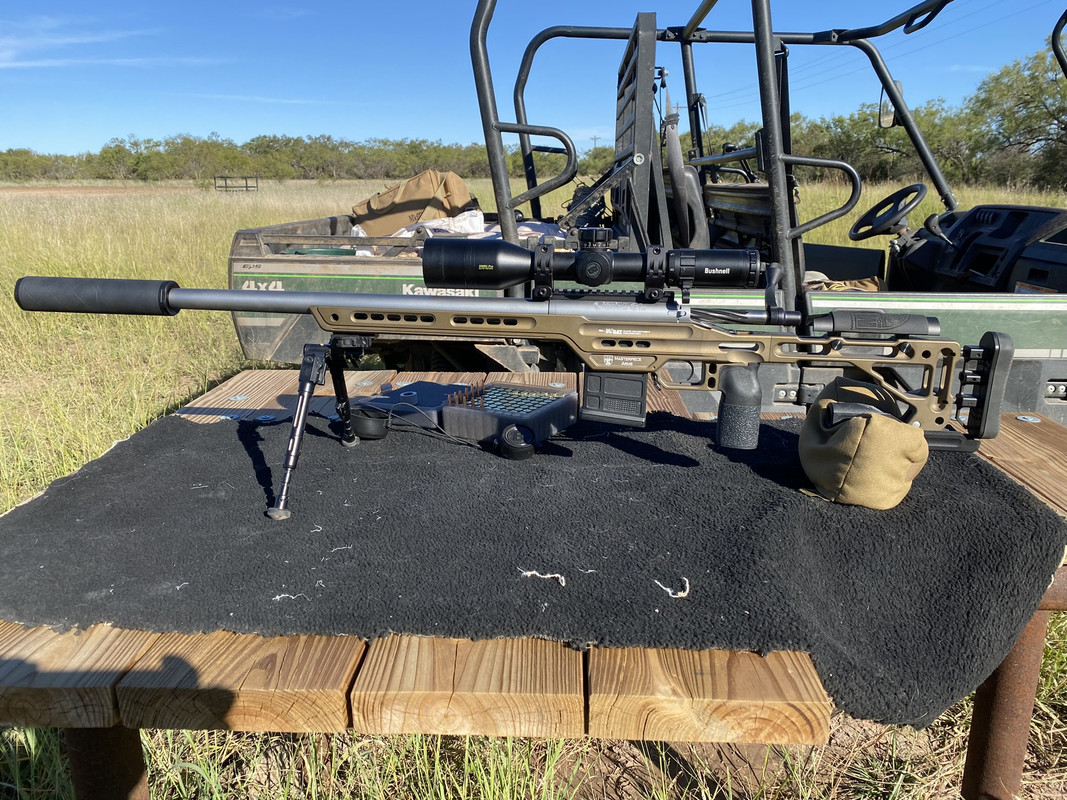
Stiller Predator action, Osprey Barrel Works M24 contour 7” twist, finished at 20”, MPA Hybrid chassis, Trigger Tech Diamond, Bushnell DMR II Pro, Stealth Project Recon suppressor.
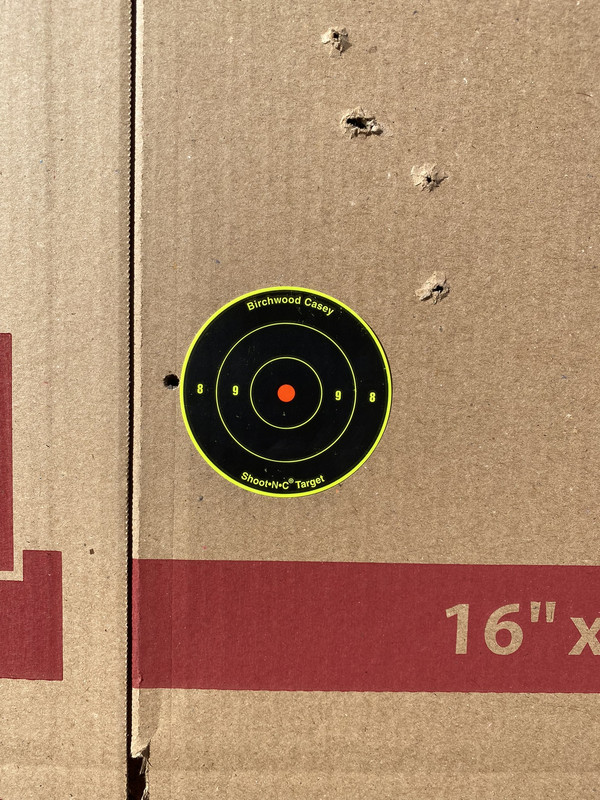
1st shot at left edge of Shoot-N-C only .5 mil from zero with previous barrel with no scope adjustment.
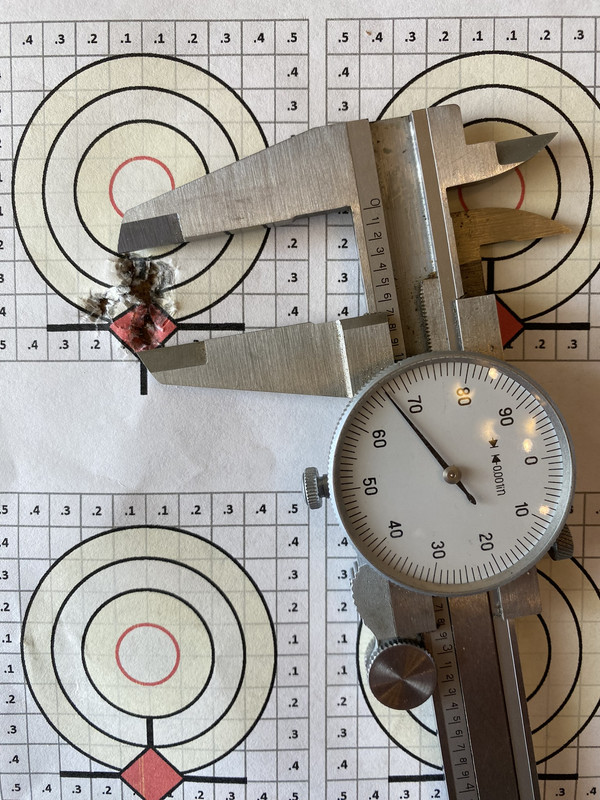
Ten shots with 35gr H4350, Hornady 88gr ELD-M, CCI450, Alpha Munitions OCD brass.
The .22 GT is simply the 6mm GT necked down to .224. It has the same case capacity as the 22-250 but in a much better designed case. The case has much less taper than the 22-250 so works much better in a DBM magazine and cases stretch much less during the firing/resizing process. COAL is short enough that reaching the lands is easy in a 2.8” or longer box.
Anyway, Jon had good things to say about the Osprey barrel. Said it was super straight, so much so that there was no need to index the curve, because there just wasn’t any. Also said the groove depth was very uniform. He thought the barrel was a bit harder than most, judging by how many plunges he made with the reemer. He cut the chamber with an Alpha Munitions reemer, and the chamber was a thing of beauty. I had him finish the barrel at 20” for suppressor use.
Loaded a few round of ammo just to try and find max. Used virgin Alpha brass, CCI 450s, H4350, and 88gr ELD-Ms. Loaded five rounds at 33.6gr to zero, and one round each of 34, 34.4, 34.8, 35.2, 35.6, and 36 to try and find max pressure. No case prep on the virgin brass, just deburring and chamfering. Used an RCBS Matchmaster 6mm GT seating die. Runout at the ogive went anywhere from .001” to .006”. I’m not satisfied with anything more than .002” runout, but with virgin brass, it’s not uncommon. I’m confident I’ll get much straighter ammo after I’ve fireformed the brass.
I’m using Magpul AICS patterned magazines and I ran five rounds through to check feeding. Feeding was flawless, which is not attainable with the 22-250 with more than five rounds, due to its case taper.
The thing that initially impressed me the most was how close the first round out of the barrel hit to the zero from the previous barrel (Bartlein 6.5 Creedmoor). Without even a boresight, the first round hit on the left edge of the bullseye, only 1/2 mil from the previous zero. I made an adjustment and shot the next four of the 33.6gr charge. They went into about .6” with 3 of the four being in the .2s. Made another adjustment and shot the last six in the pressure series. Four consecutive charges out of the remaining six went into about a .4” group. 34gr was a little out of the group, as was 36gr, but 34.4, 34.8, 35.2, and 35.6gr all went into about .4”. Based on how well 34.4 - 35.6gr grouped, I was pretty sure I could pick from 34.8 to 35.2gr and run with it. Saw no excess pressure signs from any of the charges. Bolt lift was good, no ejector marks, and primers were nice and round.
I measured some of the fired brass. When checking runout at the neck, I struggled to see any needle movement on the fired brass, indicating a very concentric chamber. Using a headspace comparator, the brass grew less than .001” on firing. I was able to slide bullets into the necks of the fired brass with my fingers but there was some resistance, indicating it’s a fairly tight necked chamber. I ran a couple of the fired brass through the Matchmaster sizing die with a .249” bushing and bumped the shoulders about .0005”. Runout at the neck on the sized cases was well under .001”.
Finally, I loaded five more rounds from 36.4 to 38gr to continue finding my max charge. The next range session I shot those, observing slight ejector marks with 37.6 and 38gr. Alpha Munitions OCD brass is seriously hard stuff and if I’m seeing ejector marks with it, I’m well past sane pressure limits, so decided to my first load development attempts in ernest would be around 36gr, hoping to find accuracy with 88gr ELD-Ms at 3000fps or more from the 20" Osprey barrel. Alas, it was not to be. This barrel decidedly did not like any charges of H4350 greater than 36gr, grouping a bit over 1" with for 10 shots. I remembered back to when I was finding max, that four consecutive charges from 34 to 35.6gr all went into the same ragged hole so decided to try 35gr. Bingo! 35gr grouped 10 shots into .443" center to center. You can see ”flyers” at 6 o’clock and 8 o’clock in the group. By the time I was six shots in, mirage off the suppressor was significant. Had it not been for that I think I could have done even better. Eight of the ten shots are probably in the high .2s. Didn't chrono it but based on come ups at 900, velocity is about 2900. I had hoped for more speed, but I don't think 100fps is going to make or break a shot. Recoil is so light that spotting your impacts is a given and it is just a super fun rifle to shoot. Overall, very pleased so far.
John

Stiller Predator action, Osprey Barrel Works M24 contour 7” twist, finished at 20”, MPA Hybrid chassis, Trigger Tech Diamond, Bushnell DMR II Pro, Stealth Project Recon suppressor.

1st shot at left edge of Shoot-N-C only .5 mil from zero with previous barrel with no scope adjustment.

Ten shots with 35gr H4350, Hornady 88gr ELD-M, CCI450, Alpha Munitions OCD brass.


